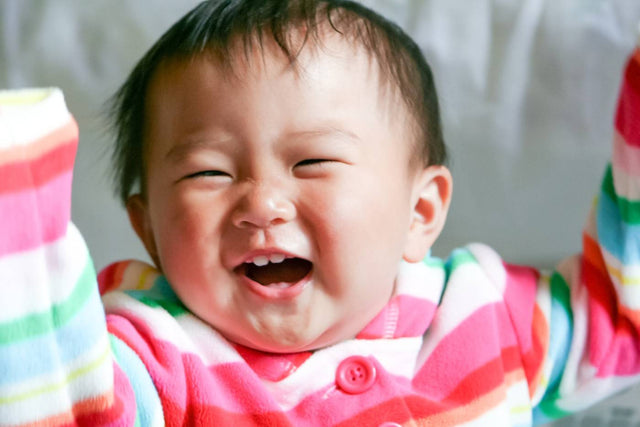Teething Schedule: When Do Babies Get Their First Tooth…and Beyond!

On This Page
A baby’s first tooth is a milestone that many parents look forward to because that toothy grin is just so darn sweet…even if the realities of teething are decidedly not. If you’ve got an upset baby on your hands because a new tooth is about to erupt from that tender pink gum line, don’t worry, relief is in sight. Here’s everything you need to know about your baby’s teething schedule, including a teething chart and timeline.
When do babies get their first tooth?
The first tooth to erupt is typically the lower central incisor (aka bottom front tooth) and it generally appears around the age of 6 to 10 months.
When do babies get molars?
Babies usually to get their first upper molars between 13 and 19 months and their first lower molars between 14 and 18 months. A baby's second set of molars typically show up between 23 and 33 months, with the top molars coming in first.
How long does teething last?
We know, teething feels never-ending when you’re in it. The bad news is that teething will last as long as it takes for all of their baby teeth to emerge. The good news? Not all teeth will cause Baby to fuss. Some kids show signs of upset as their front teeth and first molars come in and some don’t.
To alleviate teething pain, give your child a frozen washcloth to chew on (try dipping a corner in apple juice and then freezing that!) or a mesh bag with ice chips that they can suck on without risk of choking. If you breastfeed, you may notice that your baby wants to nurse more than usual, as nursing may be comforting.
Teething Schedule
Kids will eventually get two sets of teeth. The first set are called baby teeth or milk teeth and they begin to appear in the first year of life and will begin to fall out around the age of 6 or 7. The second set of teeth are called permanent teeth and they will slowly replace the baby teeth as those fall out.
Over time, your little one will rack up 20 pearly whites. Kiddos don’t sprout quite as many baby teeth as adult teeth, which begin to erupt around the age of 6 or 7 and will eventually—typically by the age of 21—total 32 permanent teeth. Here’s a typical timeline of when to expect teeth:
Baby’s Upper Teeth Schedule
- Between 8 and 12 months central incisor erupts (lost between ages 6 and 7)
- Between 9 and 13 months lateral incisor erupts (lost between ages 7 and 8)
- Between 16 and 22 months canine (cuspid) erupts (lost between ages 10 and 12)
- Between 13 and 19 months first molar erupts (lost between ages 9 and 11)
- Between 25 and 33 months second molar erupts (lost between ages 10 and 12)
Baby’s Lower Teeth Schedule
- Between 6 and 10 months central incisor erupts (lost between ages 6 and 7)
-
Between 10 and 16 months lateral incisors erupt (lost between ages 6 and 7)
- Between 14 and 18 months first molar erupts (lost between ages 9 and 11)
- Between 17 and 23 months canine (cuspid) erupts (lost between ages 9 and 12)
-
Between 23 and 31 months second molar erupts (lost between ages 9 and 11)
Permanent Upper Teeth Schedule
- First molar erupts between ages 6 and 7
- Central incisor erupts between ages 7 and 8
- Lateral incisor erupts between ages 8 and 9
- First premolar (first bicuspid) between ages 10 and 11
- Second premolar (second bicuspid) between ages 10 and 12
- Canine cuspid erupts between ages 11 and 12
- Second molar erupts between ages 12 and 13
- Third molars (wisdom teeth) erupt between ages 17 and 21
Permanent Lower Teeth Schedule
- First molar erupts between 6 and 7 years
- Central incisors erupt between 6 and 7 years
- Lateral incisors erupt between 7 and 8 years
- Canine (cuspid) erupts between 9 and 10 years
- First premolar (first bicuspid) erupts between 10 and 12 years
- Second premolar (second bicuspid) erupts between 11 and 12 years
- Second molar erupts between 11 and 13 years
- Third molar (wisdom tooth) erupts between 17 and 21 years
Baby Teething Chart
Here's a visual for a typical baby's teething schedule:

How to Care for Your Baby’s New Teeth
There are a few healthy habits that parents begin as soon as the first sign of teething appears. The sooner parents start good, healthy dental hygiene, the better off Baby’s teeth will be. Here are some general tips to keep in mind.
Avoid giving babies frozen gel packs, amber beads, or anything that has belladonna or benzocaine numbing agents in them as the FDA has issued warnings against their use.
Offer your child a frozen washcloth or food-grade baby mesh bag that can safely hold ice chips or frozen fruit to gnaw on.
Consider using a fluoride supplement by 6 months of age to help harden enamel and prevent tooth decay...if your tap water doesn’t contain fluoride. (Talk to your pediatrician about whether your baby needs fluoride supplements.)
Begin brushing Baby’s teeth twice a day with a grain-of-rice amount fluoride toothpaste on a baby toothbrush as soon as their first tooth appears. By age 3 most kids can use a pea-sized squeeze...and they should start to rinse and spit since fluoride at this amount is not healthy to ingest.
Ask your pediatrician about applying fluoride varnish to your baby’s growing teeth. This will help to prevent cavities.
Book a dentist appointment as soon as the first tooth appears and start talking to your dentist about healthy dental hygiene.